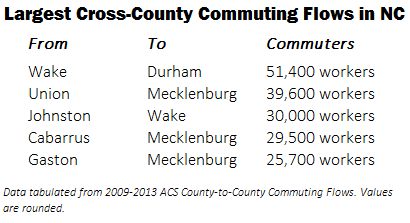County-to-County Commuting Patterns
Each week, more than 4.2 million North Carolina residents embark on a commute to work, according to recent estimates from the U.S. Census Bureau.
In most cases, the largest commuting flow is within the county, meaning most people live and work in the same county. Within county commuting occurs among the majority of county residents in 75 of the state’s 100 counties. In another 19 counties, within county commutes are the largest single commuting flow but do not represent the majority of all commutes. Two counties, Onslow and Cumberland, have the highest rate of in-county commuting: more than 90% of residents live and work within the same county.
In only 6 North Carolina counties is the largest commuting flow to a county other than their county of residence: Camden, Franklin, Hoke, Pender, Perquimans, and Stokes. The table below lists these counties and their largest destination county.
The impact of adjacent metropolitan areas is evident in these patterns. Each of the largest destination counties is home to a major regional city: Elizabeth City in Pasquotank, Raleigh in Wake, Fayetteville in Cumberland, Wilmington in New Hanover, and Winston-Salem in Forsyth.
The largest cross-county commuting flows occur within the state’s two largest metropolitan regions – the Triangle (Raleigh and Durham metro areas) and Charlotte.
 Although Wake and Mecklenburg have nearly the same number of residents who work (about 461,000 in each county), Mecklenburg County is more dominant in its region than Wake is in the Triangle. Nearly 591,000 individuals work in Mecklenburg: 402,000 individuals live and work in Mecklenburg; 59,000 live in Mecklenburg but work elsewhere; and 189,000 work in Mecklenburg but live elsewhere. In contrast, Wake has 482,000 workers; 375,000 individuals live and work in Wake, 86,000 live in Wake and work elsewhere, and 107,000 work in Wake but live elsewhere.
Although Wake and Mecklenburg have nearly the same number of residents who work (about 461,000 in each county), Mecklenburg County is more dominant in its region than Wake is in the Triangle. Nearly 591,000 individuals work in Mecklenburg: 402,000 individuals live and work in Mecklenburg; 59,000 live in Mecklenburg but work elsewhere; and 189,000 work in Mecklenburg but live elsewhere. In contrast, Wake has 482,000 workers; 375,000 individuals live and work in Wake, 86,000 live in Wake and work elsewhere, and 107,000 work in Wake but live elsewhere.
The differences between Wake and Mecklenburg reflect the significant impact of Research Triangle Park (located in Durham County) and the presence of UNC-Chapel Hill in Orange County and Duke in Durham on the overall commuting patterns in the Triangle region. Durham and Orange counties have the largest proportion of in-commuters: nearly 51% of workers in Durham and 49% of workers in Orange are not county residents.
Curious where people in your county go to work? Explore county-to-county commuting patterns (based on county of residence) in the interactive graphic below.
Your support is critical to our mission of measuring, understanding, and predicting population change and its impact. Donate to Carolina Demography today.